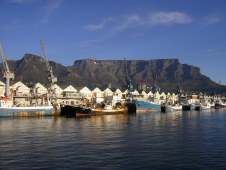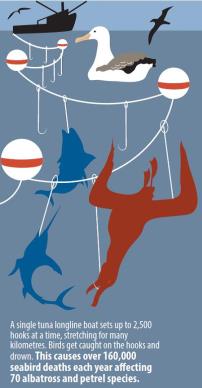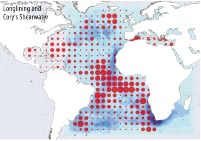
Some of the world’s richest longline fishing grounds coincide with key foraging areas for seabird species. Albatrosses and petrels, along with other seabirds, come into conflict with fisheries in these areas when they forage behind vessels for bait and fish waste, where they can become caught on hooks and drown. Between 160,000 and 320,000 seabirds are thought to be killed as bycatch in longline fisheries each year, including up to 100,000 albatrosses.

Highly productive areas of the global oceans, such as upwellings and fronts, are of key importance to the world’s commercial longline fisheries. They are also the rich foraging grounds for seabirds (BirdLife 2004).
The incidental mortality of seabirds on longlines was first reported from bird band recoveries in the early 1980s (Morant et al. 1983), resulting from birds being caught and drowned on hooks while trying to snatch bait as the lines are set (Brothers 1991). However, quantifying the scale of the problem is difficult due to the diverse and remote nature of many of the world’s fisheries, the lack of systematic reporting, and the nature of seabird bycatch rates themselves, which can be highly variable (Small et al. 2010). Nevertheless, several reviews have concluded that recent and/or current reported levels of seabird bycatch are demographically unsustainable for the populations involved (Tuck et al. 2001, Barbraud et al. 2009, Rivalan et al. 2010).
Several papers have reviewed seabird bycatch rates in both demersal (bottom) and pelagic (upper water column) longline fisheries in various regions (e.g. Brothers 1991, Dunn and Steel 2001, BirdLife 2007, Philips et al. 2007, Bugoni et al. 2008, Rivera et al. 2008, Waugh et al. 2008, Kirby et al. 2009, Waugh et al. 2012), and two attempts have been made on a global scale (Nel and Taylor 2003, Anderson et al. 2011). The most recent (Anderson et al. 2011) reviewed data collected on 68 fisheries, and covered those operating in exclusive economic zones (EEZs) as well as the high seas. The fleets identified with the highest levels of seabird bycatch include the Spanish hake fleet in the Gran Sol area, the Japanese pelagic tuna fleet in the North Pacific, the Namibian hake fleet and the Nordic demersal fleets.

The data available indicate that the vast majority of birds caught in longline fisheries are from the albatross (Diomedeidae), petrel and shearwater (Procellariidae) families, along with some species of gulls and terns (Laridae), gannets and boobies (Sulidae) and cormorants (Phalacrocoracidae). Northern Fulmar Fulmarus glacialis, Great Shearwater Puffinus gravis and White-chinned Petrel Procellaria aequinoctialis are among those caught in the highest numbers, notably in the Spanish (Gran Sol), Nordic, Russian and Namibian demersal fisheries. For fleets operating south of 20° S and in the North Pacific, albatrosses and Procellaria petrels form a larger proportion of the bycatch. While these species may be being caught in lower numbers, the impact on their populations may be greater.
Catching non-target species, like seabirds, results in time lost through removing dead birds from hooks/nets, and fish catches foregone due to bait loss; these are detrimental to fishing activities and their economic efficiency. There is therefore, at least potentially, a common interest from conservation and fishery management perspectives alike in addressing this problem.
Related Case Studies in other sections
Related Species
Links
BirdLife tracking ocean wanderers database
References
Anderson, O. R. J., Small, C. J., Croxall, J. P., Dunn, E. K., Sullivan, B. J., Yates, O. and Black, A. (2011) Global seabird bycatch in longline fisheries. Endangered Species Research 14: 91–106.
Barbraud, C., Delord, K., Marteau, C. and Weimerskirch, H. (2009) Estimates of population size of white-chinned petrels and grey petrels at Kerguelen Islands and sensitivity to fisheries. Anim. Conserv. 12: 258–265.
BirdLife International (2004) Tracking ocean wanderers: the global distribution of albatrosses and petrels. Results from the Global Procellariform Tracking Workshop, 1–5 September 2003, Gordon’s Bay, South Africa. Cambridge, UK: BirdLife International.
BirdLife international (2007) Distribution of albatrosses and petrels in the WCPFC Convention Area and overlap with WCPFC longline fishing effort. Paper submitted to WCPFC Scientific Committee Third Regular Session 13–24 August 2007, Honolulu, United States of America. WCPFC-SC3-EB SWG/IP-17.
Brothers, N. P. (1991) Albatross mortality and associated bait loss in the Japanese longline fishery in the Southern Ocean. Biol. Conserv. 55: 255–268.
Bugoni, L., Neves, T. S., Leite, N. O. Jr, Carvalho, D. and others (2008) Potential bycatch of seabirds and turtles in hook-and-line fisheries of the Itaipava Fleet, Brazil. Fish Res. 90: 217–224.
Dunn, E. and Steel, C. (2001) The impact of longline fishing on seabirds in the northeast Atlantic: recommendations for reducing mortality. NOF Rapportserie Rep. No. 5, The Royal Society for the Protection of Birds (RSPB), Sandy.
Kirby, D., Waugh, S., Filippi, D. (2009) Spatial risk indicators for seabird interactions with longline fisheries in the western and central Pacific. Western and Central Pacific Fisheries Commission-SC5-2009/EB-WP-06.
Morant, P. D., Brooke, R. K. and Abrams, R. W. (1983) Recoveries in Southern Africa of seabirds breeding elsewhere. Ringing Migr. 4: 257–268.
Nel, D. C. and Taylor, F. E. (2003) Globally threatened seabirds at risk from longline fishing: international conservation responsibilities. BirdLife International Seabird Conservation Programme, BirdLife South Africa, Cape Town. Available at www.birdlife.org/action/campaigns/save_the_albatross/fao_doc3.pdf.
Phillips, R. A. and Small, C. J. (2007) Results of the preliminary risk prioritization exercise for the ICCAT seabird assessment, updated. Paper submitted to the 2007 meeting of the ICCAT Sub-Committee on Ecosystems, Madrid, Spain, Feb 19–23, 2007, SCRS/2007/129.
Rivalan, P., Barbraud, C., Inchausti, P., Weimerskirch, H. (2010) Combined impacts of longline fisheries and climate on the persistence of the Amsterdam albatross Diomedea amsterdamensis. Ibis 152: 6–18.
Small, C., Phillips, R. A. and Waugh S. (2010) Ecological Risk Assessments for the effects of fishing: considerations for using ERAs to assess risks to albatrosses and petrels. Paper submitted to the Agreement on the Conservation of Albatrosses and Petrels Fifth Meeting of Advisory Committee. Mar del Plata, Argentina, 13 – 17 April 2010.
Tuck, G. S., Polacheck, T., Croxall, J. P. and Weimerskirch, H. (2001) Modelling the impact of fishery by-catches on albatross populations. J. Appl. Ecol. 38: 1182–1196.
Rivera, K. S., Henry, R. W. III, Shaffer, S. A., LeBoeuf, N. and VanFossen, L. (2008) Seabirds and fisheries in the IATTC area: an update. 9th Meeting of the Inter-American Tropical Tuna Commission (IATTC) Working Group on Stock Assessment, 12–16 May 2008, La Jolla, CA. IATTCSARM- 9-11a.
Waugh, S. M., Baker, G., Gales, R. and Croxall, J. P. (2008) CCAMLR process of risk assessment to minimise the effects of longline fishing mortality on seabirds. Marine Policy 32(3): 442–454.
Waugh, S. M., Filippi, D. P., Kirby, D. S., Abraham, E. and Walker, N. (2012) Ecological Risk Assessment for seabird interactions in Western and Central Pacific longline fisheries. Marine Policy doi.org/10.1016/j.marpol.2011.11.005.
Compiled: 2004 Last updated: 2013
Recommended Citation:
BirdLife International (2013)
Longline fishing effort overlaps with foraging hotspots for seabirds and causes significant bycatch .
Downloaded from https://datazone.birdlife.org/sowb/casestudy/longline-fishing-effort-overlaps-with-foraging-hotspots-for-seabirds-and-causes-significant-bycatch- on 22/12/2024